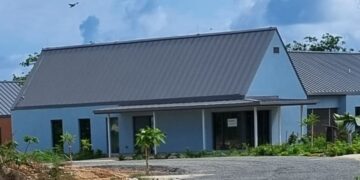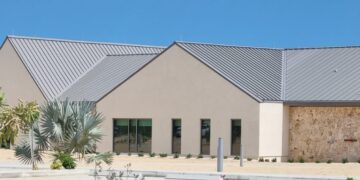(CMR) It was congratulations all around last Tuesday, 18 October, during a visit by Governor Martyn Roper to the Courts facilities at the former Bank of Nova Scotia Building, where two new state-of-the-art courtrooms have been completed and will shortly become operational.
The courtrooms are located on the ground and second floors of the building, now under development as part of the Halls of Justice complex. The second-floor courtroom has been custom-built to accommodate the recently announced historic Privy Council session to be held in Cayman in November and thereafter the Court of Appeal (CoA), but will be otherwise used for Summary and Grand Court hearings. The ground floor courtroom will be similarly utilized.
The Governor was hosted by the Chief Justice, Sir Anthony Smellie; Court Administrator Suzanne Bothwell; and Judicial Administration’s Deputy Chief Officer Natasha Scotland. The party was conducted on tour by Senior Project Manager Simon Griffiths, PWD’s Major Works lead officer and Assistant Project Manager Colin Wilson. The courtrooms comprise Phase 1 of an expansion program, the need for which was identified more than 20 years ago.
Mr. Roper complimented the Chief Justice and project managers for the “excellent” outcome of the project that, he said, had progressed at an accelerated rate since His Excellency and other top Government officials visited in March this year.
Chief Justice Smellie, on the eve of demitting office late this month after more than 24 years as Chief Justice and 29 as a judge, expressed relief that the two courtrooms were completed. He is still hopeful that a comprehensive development plan will become a reality soon.
“Cayman will need modern, state-of-the-art court facilities in order to remain at the forefront of the international financial world. A primary consideration for investors when deciding on a domicile of choice is whether, when disputes arise, as inevitably they will, the justice system will provide resolution in a timely and effective manner,” the Chief Justice said.
In addition, the departing Chief Justice said that he was equally concerned that the people of the Cayman Islands have full access to justice.
“Everyone living in Cayman must also be assured that they will have a fair and timely trial of cases which affect their rights, property, and personal security. It should go without saying that our continued ability to deliver on all these assurances will depend on having suitable court facilities,” he said.
The new courtrooms cater to the usual facilities required for a modern court—information technology, a conference room for attorneys and defendants, a sound-proof jury room, two sound-proof defendant holding areas, and a press room.
The two new courtrooms comprise the first real development of the court facilities since the current fit-for-purpose Grand Court was inaugurated in the early 1970s, Mrs. Bothwell said previously.
Tracing history, Sir Anthony said that as long as 1990, when he was Chief Justice, Sir Dennis Malone had raised the need for facilities expansion with PWD. PWD confirmed this in a late 1990s report.

In 2003, following a proposal by Ernst & Young, there were schematics for a new building at a Half Way Pond site. However, this was shelved when the effects of the 2008 world financial crisis reached Cayman.
In 2014, a team of consultants, PriceWaterhouseCoopers (PWC), in collaboration with the NORR Group—a fully integrated firm of architects, engineers, and planners— were commissioned to develop a business case for a comprehensive plan to provide for the needs of a modern court, Sir Anthony said.
The team initially presented three alternatives, but a further alternative was requested and developed in 2018-19 for building a five-story courthouse over the car park behind the existing Grand Court building. Work on the project, which was suspended due to the onset of the pandemic, is due to be resumed now that Cayman has reopened for business.
- Fascinated
- Happy
- Sad
- Angry
- Bored
- Afraid



































